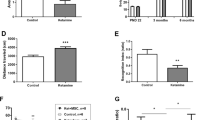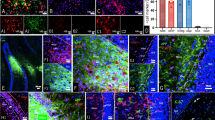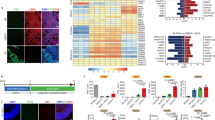Abstract
Adult bone marrow-derived mesenchymal stem cells (MSCs) are regarded as potential candidates for treatment of neurodegenerative disorders, because of their ability to promote neurogenesis. MSCs promote neurogenesis by differentiating into neural lineages as well as by expressing neurotrophic factors that enhance the survival and differentiation of neural progenitor cells. Depression has been associated with impaired neurogenesis in the hippocampus and dentate gyrus. Therefore, the aim of this study was to analyze the therapeutic potential of MSCs in the Flinders sensitive line (FSL), a rat animal model for depression. Rats received an intracerebroventricular injection of culture-expanded and 1,1′-dioctadecyl-3,3,3′,3′-tetramethylindocarbocyanine perchlorate (DiI)-labeled bone marrow-derived MSCs (105 cells). MSC-transplanted FSL rats showed significant improvement in their behavioral performance, as measured by the forced swim test and the dominant–submissive relationship (DSR) paradigm. After transplantation, MSCs migrated mainly to the ipsilateral dentate gyrus, CA1 and CA3 regions of the hippocampus, and to a lesser extent to the thalamus, hypothalamus, cortex and contralateral hippocampus. Neurogenesis was increased in the ipsilateral dentate gyrus and hippocampus of engrafted rats (granular cell layer) and was correlated with MSC engraftment and behavioral performance. We therefore postulate that MSCs may serve as a novel modality for treating depressive disorders.
This is a preview of subscription content, access via your institution
Access options
Subscribe to this journal
Receive 12 print issues and online access
$259.00 per year
only $21.58 per issue
Buy this article
- Purchase on Springer Link
- Instant access to full article PDF
Prices may be subject to local taxes which are calculated during checkout




Similar content being viewed by others
References
Trivedi MH, Rush AJ, Wisniewski SR, Nierenberg AA, Warden D, Ritz L et al. Evaluation of outcomes with citalopram for depression using measurement-based care in STAR*D: implications for clinical practice. Am J Psychiatry 2006; 163: 28–40.
Nierenberg AA, Keefe BR, Leslie VC, Alpert JE, Pava JA, Worthington III JJ et al. Residual symptoms in depressed patients who respond acutely to fluoxetine. J Clin Psychiatry 1999; 60: 221–225.
Trivedi MH, Hollander E, Nutt D, Blier P . Clinical evidence and potential neurobiological underpinnings of unresolved symptoms of depression. J Clin Psychiatry 2008; 69: 246–258.
Prockop DJ . Marrow stromal cells as stem cells for nonhematopoietic tissues. Science 1997; 276: 71–74.
Grove JE, Bruscia E, Krause DS . Plasticity of bone marrow-derived stem cells. Stem Cells 2004; 22: 487–500.
Zhang H, Huang Z, Xu Y, Zhang S . Differentiation and neurological benefit of the mesenchymal stem cells transplanted into the rat brain following intracerebral hemorrhage. Neurol Res 2006; 28: 104–112.
Crigler L, Robey RC, Asawachaicharn A, Gaupp D, Phinney DG . Human mesenchymal stem cell subpopulations express a variety of neuro-regulatory molecules and promote neuronal cell survival and neuritogenesis. Exp Neurol 2006; 198: 54–64.
Munoz JR, Stoutenger BR, Robinson AP, Spees JL, Prockop DJ . Human stem/progenitor cells from bone marrow promote neurogenesis of endogenous neural stem cells in the hippocampus of mice. Proc Natl Acad Sci 2005; 102: 18171–18176.
Yoo SW, Kim SS, Lee SY, Lee HS, Kim HS, Lee YD et al. Mesenchymal stem cells promote proliferation of endogenous neural stem cells and survival of newborn cells in a rat stroke model. Exp Mol Med 2008; 40: 387–397.
Hamada H, Kobune M, Nakamura K, Kawano Y, Kato K, Honmou O et al. Mesenchymal stem cells (MSC) as therapeutic cytoreagents for gene therapy. Cancer Sci 2005; 96: 149–156.
Dezawa M . Systematic neuronal and muscle induction systems in bone marrow stromal cells: the potential for tissue reconstruction in neurodegenerative and muscle degenerative diseases. Med Mol Morphol 2008; 41: 14–19.
Karussis D, Kassis I, Kurkalli BG, Slavin S . Immunomodulation and neuroprotection with mesenchymal bone marrow stem cells (MSCs): a proposed treatment for multiple sclerosis and other neuroimmunological/neurodegenerative diseases. J Neurol Sci 2008; 265: 131–135.
Kan I, Melamed E, Offen D . Autotransplantation of bone marrow-derived stem cells as a therapy for neurodegenerative diseases. Handb Exp Pharmacol 2007; 180: 219–242.
Dranovsky A, Hen R . Hippocampal neurogenesis: regulation by stress and antidepressants. Biol Psychiatry 2006; 59: 1136–1143.
Thomas RM, Hotsenpiller G, Peterson DA . Acute psychosocial stress reduces cell survival in adult hippocampal neurogenesis without altering proliferation. J Neurosci 2007; 27: 2734–2743.
Fossati P, Radtchenko A, Boyer P . Neuroplasticity: from MRI to depressive symptoms. Eur Neuropsychopharmacol 2004; 14 (Suppl 5): S503–S510.
Husum SA . Exacerbated loss of cell survival, neuropeptide Y-immunoreactive (IR) cells, and serotonin-IR fiber lengths in the dorsal hippocampus of the aged flinders sensitive line ‘depressed’ rat: implications for the pathophysiology of depression? J Neurosci Res 2006; 84: 1292–1302.
Gronli J, Bramham C, Murison R, Kanhema T, Fiske E, Bjorvatn B et al. Chronic mild stress inhibits BDNF protein expression and CREB activation in the dentate gyrus but not in the hippocampus proper. Pharmacol Biochem Behav 2006; 85: 842–849.
Gaughran F, Payne J, Sedgwick PM, Cotter D, Berry M . Hippocampal FGF-2 and FGFR1 mRNA expression in major depression, schizophrenia and bipolar disorder. Brain Res Bull 2006; 70: 221–227.
Kempermann G, Krebs J, Fabel K . The contribution of failing adult hippocampal neurogenesis to psychiatric disorders. Curr Opin Psychiatry 2008; 21: 290–295.
Malberg JE, Schechter LE . Increasing hippocampal neurogenesis: a novel mechanism for antidepressant drugs. Curr Pharm Des 2005; 11: 145–155.
Peister A, Zeitouni S, Pfankuch T, Reger RL, Prockop DJ, Raber J . Novel object recognition in Apoe−/− mice improved by neonatal implantation of wild-type multipotential stromal cells. Exp Neurol 2006; 201: 266–269.
Ben Shaanan TL, Ben Hur T, Yanai J . Transplantation of neural progenitors enhances production of endogenous cells in the impaired brain. Mol Psychiatry 2007; 13: 222–231.
Yadid G, Friedman A . Dynamics of the dopaminergic system as a key component to the understanding of depression. In: Di Giovanni G, Di Matteo V, Esposito E (eds). Progress in Brain Research Serotonin-Dopamine Interaction: Experimental Evidence and Therapeutic Relevance, Vol. 172 edn. Elsevier: Amsterdam, 2008 pp. 265–286.
Overstreet DH, Friedman E, Mathe AA, Yadid G . The flinders sensitive line rat: a selectively bred putative animal model of depression. Neurosci Biobehav Rev 2005; 29: 739–759.
Zangi L, Rivkin R, Kassis I, Levdansky L, Marx G, Gorodetsky R . High-yield isolation, expansion, and differentiation of rat bone marrow derived mesenchymal stem cells with fibrin microbeads. Tissue Eng 2006; 12: 2343–2354.
Dai W, Hale SL, Martin BJ, Kuang JQ, Dow JS, Wold LE et al. Allogeneic mesenchymal stem cell transplantation in postinfarcted rat myocardium: short- and long-term effects. Circulation 2005; 112: 214–223.
Genud R, Merenlender A, Gispan-Herman I, Maayan R, Weizman A, Yadid G . DHEA lessens depressive-like behavior via GABA-ergic modulation of the mesolimbic system. Neuropsychopharmacology 2008; 34: 577–584.
Malatynska E, Knapp RJ . Dominant-submissive behavior as models of mania and depression. Neurosci Biobehav Rev 2005; 29: 715–737.
Friedman A, Frankel M, Flaumenhaft Y, Merenlender A, Pinhasov A, Feder Y et al. Programmed acute electrical stimulation of ventral tegmental area alleviates depressive-like behavior. Neuropsychopharmacology 2009; 34: 1057–1066.
Shetty AK, Rao MS, Hattiangady B . Behavior of hippocampal stem/progenitor cells following grafting into the injured aged hippocampus. J Neurosci Res 2008; 86: 3062–3074.
Sinead MG . Differentiation of oligodendrocytes in neurospheres derived from embryonic rat brain using growth and differentiation factors. J Neurosci Res 2007; 85: 1912–1920.
Jin GZ, Cho SJ, Choi EG, Lee YS, Yu XF, Choi KS et al. Rat mesenchymal stem cells increase tyrosine hydroxylase expression and dopamine content in ventral mesencephalic cells in vitro. Cell Biol Int 2008; 32: 1433–1438.
Koh SH, Noh MY, Cho GW, Kim KS, Kim SH . Erythropoietin increases the motility of human bone marrow multipotent stromal cells (hBM-MSCs) and enhances the production of neurotrophic factors from hBM-MSCs. Stem Cells Dev 2009; 18: 411–421.
Hardy SA, Maltman DJ, Przyborski SA . Mesenchymal stem cells as mediators of neural differentiation. Curr Stem Cell Res Ther 2008; 3: 43–52.
Lou SJ, Gu P, Chen F, He C, Wang MW, Lu CL . The effect of bone marrow stromal cells on neuronal differentiation of mesencephalic neural stem cells in Sprague-Dawley rats. Brain Res 2003; 968: 114–121.
Pomp O, Brokhman I, Ziegler L, Almog M, Korngreen A, Tavian M et al. PA6-induced human embryonic stem cell-derived neurospheres: a new source of human peripheral sensory neurons and neural crest cells. Brain Res 2008; 1230: 50–60.
Scuteri A, Donzelli E, Ravasi M, Tredici G . Adult mesenchymal stem cells support cisplatin-treated dorsal root ganglion survival. Neurosci Lett 2008; 445: 68–72.
Hellmann MA, Panet H, Barhum Y, Melamed E, Offen D . Increased survival and migration of engrafted mesenchymal bone marrow stem cells in 6-hydroxydopamine-lesioned rodents. Neurosci Lett 2006; 395: 124–128.
Sadan O, Shemesh N, Barzilay R, Bahat-Stromza M, Melamed E, Cohen Y et al. Migration of neurotrophic factors-secreting mesenchymal stem cells toward a quinolinic acid lesion as viewed by magnetic resonance imaging. Stem Cells 2008; 26: 2542–2551.
Wu X, Hu J, Zhou L, Mao Y, Yang B, Gao L et al. In vivo tracking of superparamagnetic iron oxide nanoparticle-labeled mesenchymal stem cell tropism to malignant gliomas using magnetic resonance imaging laboratory investigation. J Neurosurg 2008; 108: 320–329.
Nakamura K, Ito Y, Kawano Y, Kurozumi K, Kobune M, Tsuda H et al. Antitumor effect of genetically engineered mesenchymal stem cells in a rat glioma model. Gene Therapy 2004; 11: 1155–1164.
Bexell D, Gunnarsson S, Tormin A, Darabi A, Gisselsson D, Roybon L et al. Bone marrow multipotent mesenchymal stroma cells act as pericyte-like migratory vehicles in experimental gliomas. Mol Ther 2009; 17: 183–190.
Phinney DG, Baddoo M, Dutreil M, Gaupp D, Lai WT, Isakova IA . Murine mesenchymal stem cells transplanted to the central nervous system of neonatal versus adult mice exhibit distinct engraftment kinetics and express receptors that guide neuronal cell migration. Stem Cells Dev 2006; 15: 437–447.
Isakova IA, Baker K, DuTreil M, Dufour J, Gaupp D, Phinney DG . Age- and dose-related effects on MSC engraftment levels and anatomical distribution in the central nervous systems of nonhuman primates: identification of novel MSC subpopulations that respond to guidance cues in brain. Stem Cells 2007; 25: 3261–3270.
Kopen GC, Prockop DJ, Phinney DG . Marrow stromal cells migrate throughout forebrain and cerebellum, and they differentiate into astrocytes after injection into neonatal mouse brains. Proc Natl Acad Sci USA 1999; 96: 10711–10716.
Lee RH, Hsu SC, Munoz J, Jung JS, Lee NR, Pochampally R et al. A subset of human rapidly self-renewing marrow stromal cells preferentially engraft in mice. Blood 2006; 107: 2153–2161.
Qu C, Mahmood A, Lu D, Goussev A, Xiong Y, Chopp M . Treatment of traumatic brain injury in mice with marrow stromal cells. Brain Res 2008; 1208: 234–239.
Hardy SA, Maltman DJ, Przyborski SA . Mesenchymal stem cells as mediators of neural differentiation. Curr Stem Cell Res Ther 2008; 3: 43–52.
Petersén A, Wörtwein G, Gruber SH, Mathé AA . Escitalopram reduces increased hippocampal cytogenesis in a genetic rat depression model. Neurosci Lett 2008; 436: 305–308.
Tran PB, Banisadr G, Ren D, Chenn A, Miller RJ . Chemokine receptor expression by neural progenitor cells in neurogenic regions of mouse brain. J Comp Neurol 2007; 500: 1007–1033.
Berger O, Li G, Han SM, Paredes M, Pleasure SJ . Expression of SDF-1 and CXCR4 during reorganization of the postnatal dentate gyrus. Dev Neurosci 2007; 29: 48–58.
Rai KS, Hattiangady B, Shetty AK . Enhanced production and dendritic growth of new dentate granule cells in the middle-aged hippocampus following intracerebroventricular FGF-2 infusions. Eur J Neurosci 2007; 26: 1765–1779.
Laskowski A, Schmidt W, Dinkel K, Martínez-Sánchez M, Reymann KG . bFGF and EGF modulate trauma-induced proliferation and neurogenesis in juvenile organotypic hippocampal slice cultures. Brain Res 2005; 1037: 78–89.
Kroes RA, Panksepp J, Burgdorf J, Otto NJ, Moskal JR . Modeling depression: social dominance-submission gene expression patterns in rat neocortex. Neuroscience 2006; 137: 37–49.
Duan X, Kang E, Liu CY, Ming Gl, Song H . Development of neural stem cell in the adult brain. Curr Opin Neurobiol 2008; 18: 108–115.
Lie DC, Colamarino SA, Song HJ, Desire L, Mira H, Consiglio A et al. Wnt signalling regulates adult hippocampal neurogenesis. Nature 2005; 437: 1370–1375.
Lim DA, Tramontin AD, Trevejo JM, Herrera DG, García-Verdugo JM, Alvarez-Buylla A . Noggin antagonizes BMP signaling to create a niche for adult neurogenesis. Neuron 2000; 28: 713–726.
Bonaguidi MA, McGuire T, Hu M, Kan L, Samanta J, Kessler JA . LIF and BMP signaling generate separate and discrete types of GFAP-expressing cells. Development 2005; 132: 5503–5514.
Bjornebekk A, Mathe AA, Brene S . The antidepressant effect of running is associated with increased hippocampal cell proliferation. Int J Neuropsychopharmacol 2005; 8: 357–368.
Cunningham MG, Donalds RA, Carlezon WAJ, Hong S, Kim DS, Kim DW et al. Antidepressant effect of stem cell-derived monoaminergic grafts. [Miscellaneous Article]. NeuroReport 2007; 18: 1663–1667.
Malatynska E, Rapp R, Harrawood D, Tunnicliff G . Submissive behavior in mice as a test for antidepressant drug activity. Pharmacol Biochem Behav 2005; 82: 306–313.
Mochizuki N, Takagi N, Onozato C, Moriyama Y, Takeo S, Tanonaka K . Delayed injection of neural progenitor cells improved spatial learning dysfunction after cerebral ischemia. Biochem Biophys Res Commun 2008; 368: 151–156.
Mochizuki N, Takagi N, Kurokawa K, Onozato C, Moriyama Y, Tanonaka K et al. Injection of neural progenitor cells improved learning and memory dysfunction after cerebral ischemia. Exp Neurol 2008; 211: 194–202.
Toda H, Takahashi J, Iwakami N, Kimura T, Hoki S, Mozumi-Kitamura K et al. Grafting neural stem cells improved the impaired spatial recognition in ischemic rats. Neurosci Lett 2001; 316: 9–12.
Chopp M, Li Y . Treatment of neural injury with marrow stromal cells. Lancet Neurol 2002; 1: 92–100.
Qu T, Brannen CL, Kim HM, Sugaya KC . Human neural stem cells improve cognitive function of aged brain. NeuroReport 2001; 12: 1127–1132.
Wu S, Sasaki A, Yoshimoto R, Kawahara Y, Manabe T, Kataoka K et al. Neural stem cells improve learning and memory in rats with Alzheimer's disease. Pathobiology 2008; 75: 186–194.
Frinchi M, Bonomo A, Trovato-Salinaro A, Condorelli DF, Fuxe K, Spampinato MG et al. Fibroblast growth factor-2 and its receptor expression in proliferating precursor cells of the subventricular zone in the adult rat brain. Neurosci Lett 2008; 447: 20–25.
Maric D, Fiorio Pla A, Chang YH, Barker JL . Self-renewing and differentiating properties of cortical neural stem cells are selectively regulated by basic fibroblast growth factor (FGF) signaling via specific FGF receptors. J Neurosci 2007; 27: 1836–1852.
Kalluri HS, Dempsey RJ . Growth factors, stem cells, and stroke. Neurosurg Focus 2008; 24: E14.
Reuss B, von Bohlen und Halbach O . Fibroblast growth factors and their receptors in the central nervous system. Cell Tissue Res 2003; 313: 139–157.
Gaughran F, Payne J, Sedgwick PM, Cotter D, Berry M . Hippocampal FGF-2 and FGFR1 mRNA expression in major depression, schizophrenia and bipolar disorder. Brain Res Bull 2006; 70: 221–227.
Evans SJ, Choudary PV, Neal CR, Li JZ, Vawter MP, Tomita H et al. Dysregulation of the fibroblast growth factor system in major depression. Proc Natl Acad Sci USA 2004; 101: 15506–15511.
Aonurm-Helm A, Jurgenson M, Zharkovsky T, Sonn K, Berezin V, Bock E et al. Depression-like behaviour in neural cell adhesion molecule (NCAM)-deficient mice and its reversal by an NCAM-derived peptide, FGL. Eur J Neurosci 2008; 28: 1618–1628.
Turner CA, Calvo N, Frost DO, Akil H, Watson SJ . The fibroblast growth factor system is downregulated following social defeat. Neurosci Lett 2008; 430: 147–150.
Turner CA, Gula EL, Taylor LP, Watson SJ, Akil H . Antidepressant-like effects of intracerebroventricular FGF2 in rats. Brain Res 2008; 1224: 63–68.
Jacobs BL, Praag H, Gage FH . Adult brain neurogenesis and psychiatry: a novel theory of depression. Mol Psychiatry 2000; 5: 262–269.
Eisch AJ, Cameron HA, Encinas JM, Meltzer LA, Ming GL, Overstreet-Wadiche LS . Adult neurogenesis, mental health, and mental illness: hope or hype? J Neurosci 2008; 28: 11785–11791.
Balu DT, Lucki I . Adult hippocampal neurogenesis: regulation, functional implications, and contribution to disease pathology. Neurosci Biobehav Rev 2009; 33: 232–252.
Sahay A, Drew MR, Hen R . Dentate gyrus neurogenesis and depression. In: Scharfman HE (ed). Progress in Brain Research). The Dentate Gyrus: A Comprehensive Guide to Structure, Function, and Clinical Implications, 163 edn. Elsevier: Amsterdam, 2007, pp 697–722, 822.
Acknowledgements
We thank Dr Albert Pinhasov, Department of Molecular Biology, Ariel University Center of Samaria for his helpful comments and Mrs Esther Furman for editing this paper.
Author information
Authors and Affiliations
Corresponding author
Ethics declarations
Competing interests
The authors declare no conflict of interest.
Rights and permissions
About this article
Cite this article
Tfilin, M., Sudai, E., Merenlender, A. et al. Mesenchymal stem cells increase hippocampal neurogenesis and counteract depressive-like behavior. Mol Psychiatry 15, 1164–1175 (2010). https://doi.org/10.1038/mp.2009.110
Received:
Revised:
Accepted:
Published:
Issue Date:
DOI: https://doi.org/10.1038/mp.2009.110
Keywords
This article is cited by
-
Whole transcriptome analysis in offspring whose fathers were exposed to a developmental insult: a novel avian model
Scientific Reports (2023)
-
Potential Plausible Role of Stem Cell for Treating Depressive Disorder: a Retrospective Review
Molecular Neurobiology (2023)
-
Connexin 43: insights into candidate pathological mechanisms of depression and its implications in antidepressant therapy
Acta Pharmacologica Sinica (2022)
-
Gut microbiota is involved in the antidepressant effects of adipose-derived mesenchymal stem cells in chronic social defeat stress mouse model
Psychopharmacology (2022)
-
Transplantation of mesenchymal stem cells causes long-term alleviation of schizophrenia-like behaviour coupled with increased neurogenesis
Molecular Psychiatry (2021)



